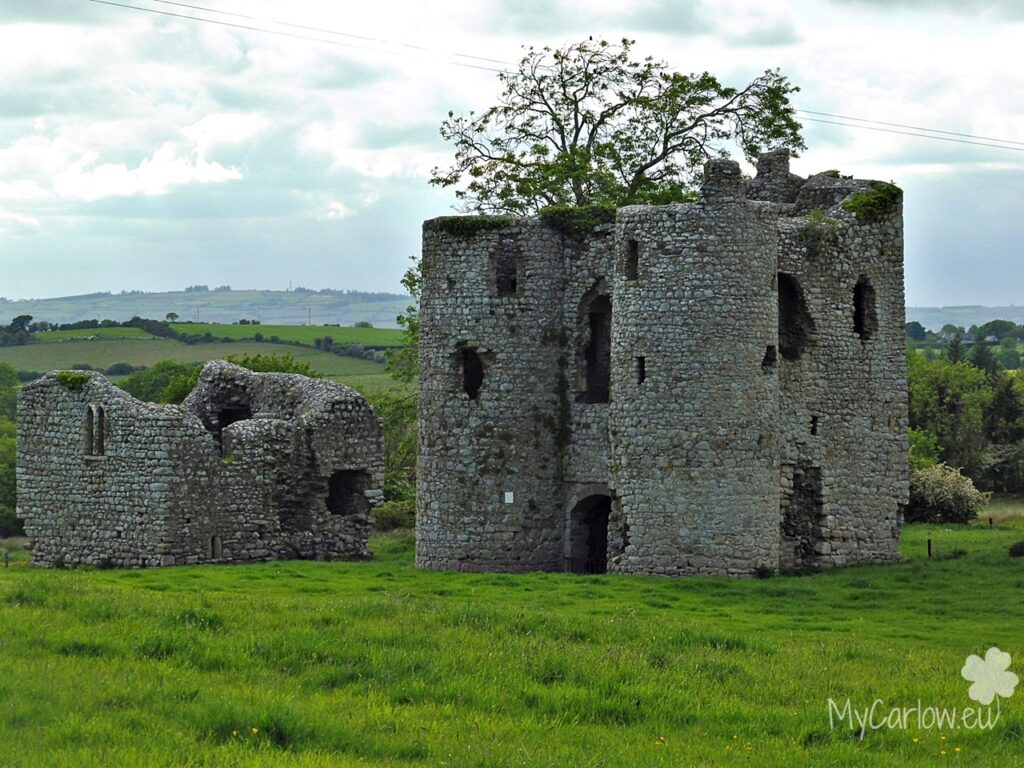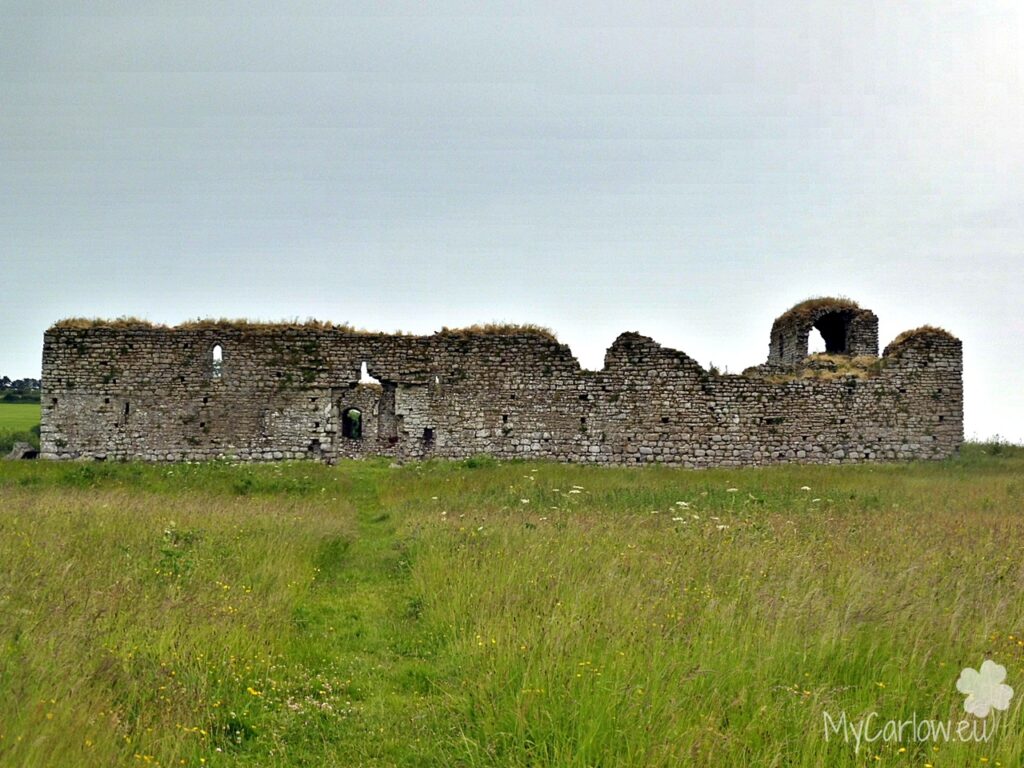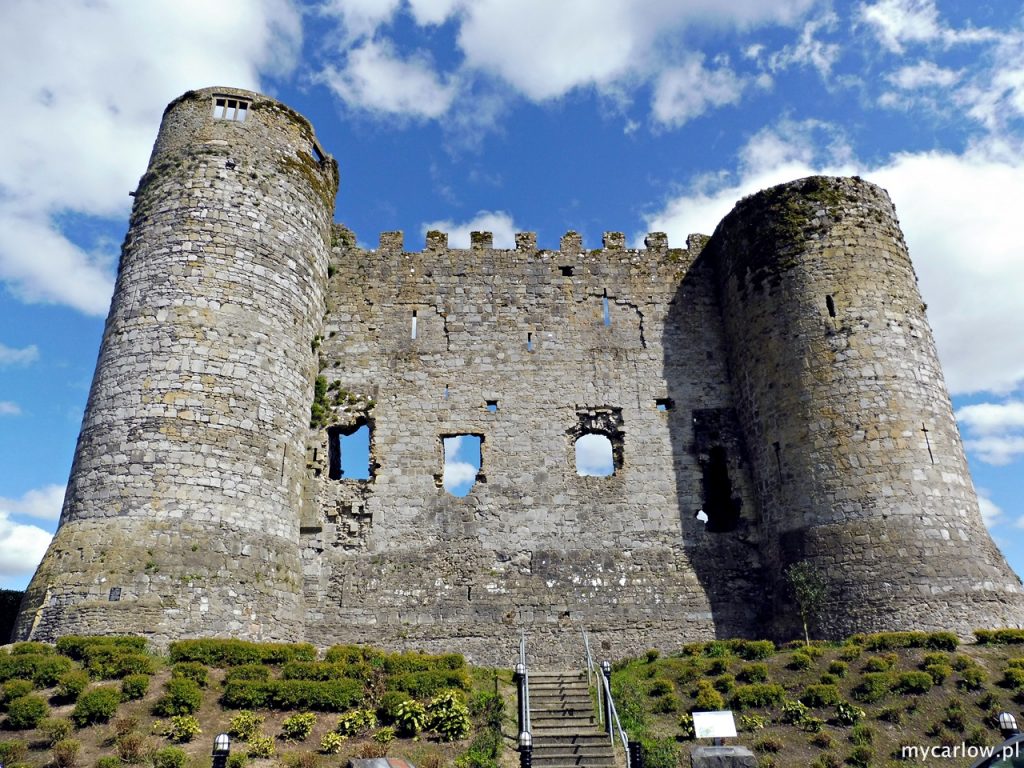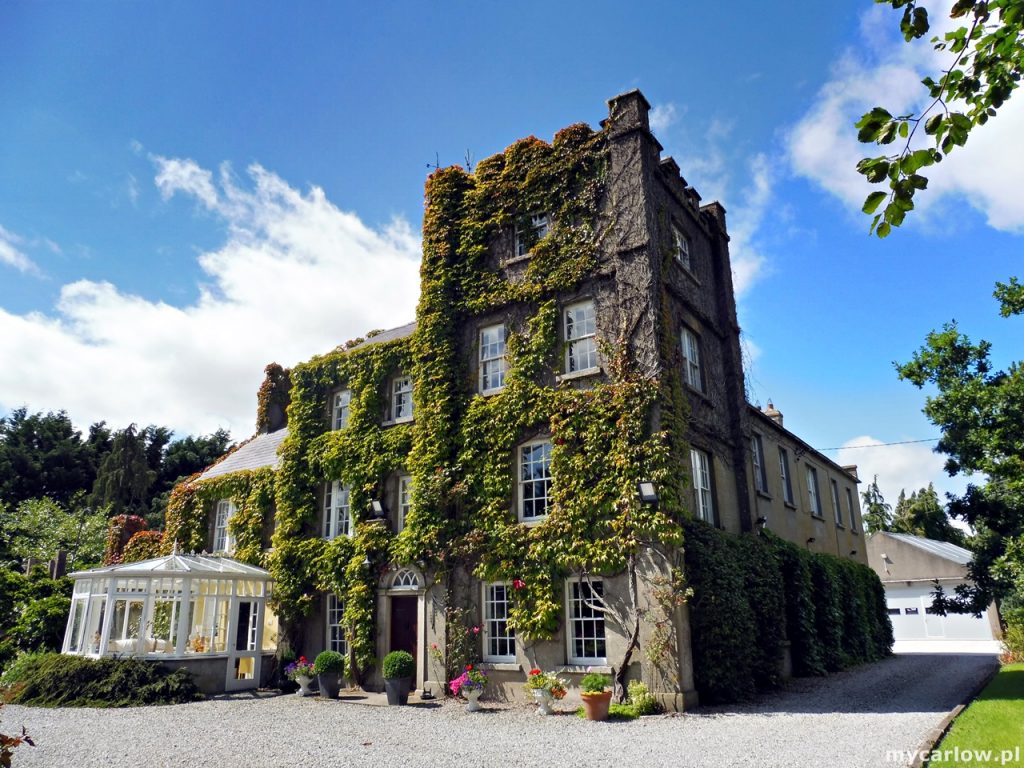
So far I visited 10 Castles in County Carlow.
County Carlow’s historical attractions are many. Including a number of fine castles, from medieval ruins and the National Monuments of Ireland to a fully preserved castle open to the public, and also, the castle which is now a private house.
Writers over the years have claimed that there were over 150 castles in County Carlow. Succeeded in identifying the sites of 93. On the website Carlow County – Ireland Genealogical Projects (IGP TM), you can see info about Castles of Co. Carlow: www.igp-web.com/Carlow/castles_of_carlow
What`s more, County Carlow possesses several of the most interesting medieval castles in Ireland. Of the fortresses known to have been built between c. 1200 and c. 1320, as many as four survive ( Carlow, Ballyloughan, Ballymoon, and Clonmore). Also, one of the most interesting and historic treasures of Ireland, not only County Carlow is Huntington Castle, voted one of Ireland’s top 20 Hidden Gems by The Guardian.
10 Castles in County Carlow
1. Ballyloughan Castle
Ballyloughan Castle is a ruined castle and National Monument of Ireland, located near Bagenalstown.
Today, a twin-towered gatehouse, the hall, and the foundations of one of the corner towers, dating to about 1300 remain. Furthermore, Ballyloughan`s gatehouse, which protected the entrance to the castle, is one of the finest examples of its type in Ireland.
Ballyloughan Castle was probably built in the 13th century. It consisted of a large open courtyard with a curtain wall and a moat outside. Only a small square tower of Ballyloughan Castle remains. As well as the entrance gate which is flanked by two large rounded towers.
Archeological excavation in 1955 revealed that the castle had been surrounded by a ditch. But, this had been refiled early in the castle`s history. Finds from the excavation included a silver finger ring from the 14th century. The ruined house overlooking the castle was built in the 17th century.
Moreover, Ballyloughan Castle originally belonged to the Kavanaghs before passing into the hands of the Bagenal family of nearby Bagenalstown. Then, following this the Bruen family in the early 19th century.
Unfortunately, the Castle is located on private land, and no access is allowed. But, it may be viewed from the nearby adjacent gate.
2. Ballymoon Castle
Ballymoon Castle is one of the most unique and mysterious. It is situated in the Barrow Valley, approximately 2 miles (3 km) east of Muine Bheag (Bagenalstown). So, it is only 3,8 km from Ballyloughan Castle. What`s more, it is a valuable National Monument of Ireland.
Ballymoon has no recorded history. But for architectural reasons, it is believed to have been built in the 13th century by Anglo-Normans. And it was designed as a defensive fortress. Much of the history has been lost. But it is thought to have been built by Roger Bigod, 5th Earl of Norfolk, in turbulent times. Or by the Carew family, who acquired the land when Bigod died without issue. In the late 1800s, the castle was bought by Michael Sheill from Wexford who established a number of local businesses. The castle was never completed, and its construction was interrupted. The cause is unknown, but given that construction began during a chaotic period in Irish history. And it seems that things did not turn out well for the builders.
The castle is accessible to the public.
Located in a field next to Fennagh Road. With access via a small wooden bridge over a ditch. Visitors can access the castle walls at ground level. Sightseeing: walking inside and around the castle takes about half an hour.
The castle is in ruins, consisting of a square courtyard of about 80 feet. And surrounded on each side by 20 feet high granite walls which are about 8 feet wide at the base. The interior of the castle is open. So, in the walls, you can see where the doors and fireplaces were to be placed. The large double fireplace on the north side was part of the great hall. There are no signs of the castle’s internal structure other than the foundations. So, this has just led to speculation that the castle was never completed. The wall on the west side has an arched gate. The grooves that can be seen above the gate suggest that there may have been a barbican. In the castle walls, you can see many mysterious crevices with strange shapes, such as guns, loops, keys, and arrows.
3. Black Castle
Black Castle is located in Leighlinbridge, County Carlow, and is also known as Leighlinbridge Castle.
The original Black Castle, built in 1181, was one of the earliest and finest Norman fortresses in Ireland. Castle was granted to John de Claville by Hugh de Lacy. The powerful Norman Baron governed Ireland for Henry II.
This Castle was built to protect a strategic crossing point over the river Barrow. The river crossing was defended in the late 12th and 13th centuries by an Anglo-Norman castle a short distance downriver. A Carmelite friary was founded here in the 1260s. And the earlier part of the present tower was built in the 14th century to protect the friary. Then the adjacent bridge was built by Maurice Jakis, a canon of Kildare Cathedral.
In 1547, after the friary was dissolved in Henry VIIIs campaign to control the wealth and power of the Church. Sir Edward Bellingham, the English Lord Deputy, rebuilt much of the tower. Also, refortified the bawn wall by adding a circular gun turret. Sir Peter Carew of Devon owned the castle in 1567. But Rory Óg O`More, a local Irish chieftain, captured and destroyed it in 1577. It was partly rebuilt, but was attacked again by the Cromwellian armies; half of the tower collapsed in 1888.
All that remains of the Black Castle today is the west half of a 14th-century tower.
And along with part of the bawn. So, the remains of the castle are now dilapidated – a 50-foot-tall (15 m) broken castle tower. And parts of one side of an enclosing wall are still extant.
Black Castle is located on the southeastern side of the Valerian Bridge. The bridge crosses the Barrow River and it is accessible directly from the river towpath. It is a National Monument of Ireland.
4. Carlow Castle
One of the most valuable monuments in Carlow Town is the ruins of a medieval fortified castle.
Carlow Castle is located on the banks of the River Barrow. And there is a first monument which I visited in Carlow Town and have taken my first photos. So I can say here started the idea of posting mycarlow blog. I remember very well that sunny day on March 2014. And I will always have sentiment for the ruins of Carlow Castle. I consider they are beautiful.
The fortress was built in the first half of the 13th century. Moreover, in the place of a wooden fortified stronghold by William Marshal the Elder. In the time period between 1207 and 1213, he spent in Ireland.
The castle in Carlow was the very first of its kind in Ireland.
A towered keep, where a huge rectangular tower is surrounded by four smaller three-quarter circular towers at the corners of the rectangle.
In the following centuries, the castle changed hands many times. Successively ruled by the English kings, FitzGerald and earls Norfolk and Thomond. Bought by the Earl of Thomond in 1616, changed hands multiple times. Until it was taken by Oliver Cromwell in 1650. But was later returned to the Earl of Thomond. When in the 17th century the stronghold lost its strategic significance. It was abandoned and neglected since that time, it began to fall into increasing ruin.
In 1814 the castle was widely destroyed in an attempt to create more space for the conversion into a distraught asylum with the help of explosives. Too many explosives were used for the reconstruction, so most of the castle just collapsed.
Today, only two defensive towers and fragments of walls remain from this once impressive fortress.
Therefore Carlow Castle is the oldest stone castle in Ireland and the National Monument of Ireland.
5. Clogrennane Castle
On the way to Clogrennan Wood, you will see this beautiful arch. And the lovely setting beside the River Barrow – this is Clogrennane Castle. Located about two miles distant from Carlow town. And this is one of the National Monuments of Ireland in County Carlow.
Clogrennane Castle was built sometime in the 15th century. In order to defend a pass that wound along between the River Barrow and the extensive woodlands. They were all along the side of the hills. It is believed to be in ruins since the 18th century. And in the 19th century, it was converted into the entrance to the then-newly built Clogrennane House. The ruins bear little resemblance to the original Castle and seem to incorporate stone from a nearby ancient church.
Near the ivy-covered ruin of the old castle, a tunnel has been discovered. Said to connect Clogrennan with White’s Castle (the modern house on Graiguecullen Bridge is built on the site of this castle) and Carlow Castle.
6. Clonmore Castle
Not far from Hacketstown, in the east of County Carlow and the outskirts of Clonmore village can be found the ruin of Clonmore Castle. Moreover, of all the castles of County Carlow (and in the fifteenth century, there were at least one hundred and fifty) none has more impressive remains than that of the castle of Clonmore.
The castle once had to be truly magnificent and majestic, but now is forgotten, neglected, and broken.
It is believed to have been built at the end of the 12th century. Possibly by Hugh DeLacey, and expanded in 1332 by Anthony DeLucy. The castle is now badly damaged.
The history of the castle, like many others in this area, was very turbulent. It underwent many attacks, incl. – in 1650 it suffered significantly after an attack by Cromwell’s army.
The remains indicate that the castle was built on a square plan. With rectangular towers on the south side of the courtyard. In the part of the preserved southern wall of the castle, there is a clover-shaped window. Characteristic of 13th-century buildings. Therefore it is assumed that this part of the castle was built at the end of the 13th century.
The ruins of the castle hide many chambers and corridors. But their condition does not allow visiting. You can see numerous cracks, and crevices formed by bushes and trees growing into the ruins. So, it is better to admire the castle only from the outside and also with caution.
7. Huntington Castle
Huntington Castle is also known as Clonegal Castle. From the name of Clonegal village in County Carlow. It was the ancient seat of the Esmonde family and today is one of Ireland’s historical treasures. Voted one of Ireland’s top 20 Hidden Gems by The Guardian.
The castle was built in 1400 as a fortress for the Caviness family. An old Irish clan, on the site of a former convent. Originally, the Castle was used for defense purposes as a garrison. Due to the strategic location of the village of Clonegal during the Cromwell Campaign in Ireland.
At the beginning of the 17th century, Clonegal Castle, the surrounding marsh meadows and orchards became the property of Sir Laurence Esmonde. Therefore, the castle in its present form owes its decorative architecture to the First Lord Esmonde. He rebuilt it in 1625, replacing an earlier fortress and his grandson called it “Huntington”.
Currently, Huntington Castle is open to the public.
It can be visited with a guide, usually one of the family’s descendants.
The story of Huntington Castle is unusual in Ireland. Because the Esmonde/Durdin Robertson family has been there for centuries. What`s more, they managed to avoid the usual unhappy fate of the Irish gentry and so their castle escaped intact. Thus the family still lives there, surrounded by centuries of history.
The castle is not big but beautiful. The interiors are interesting, full of interesting items, about which the guide tells various anecdotes. For example, when a crocodile skull was prepared. One of the aunts recalls who, at the age of 16, killed this formidable owner of the skull. So, the vines are climbing on the ceiling of the conservatory. It is supposed to come directly from a group given to the family by Anna Boleyn.
Meanwhile, in the castle cellars, which formerly housed the treasury and the castle kitchen. Now there is a Temple of the Goddess Isis.
There are various myths that Huntington Castle is haunted by ghosts. Including Druid spirits, their ghostly figures most often appear in a place called Yew Walk. There is a 600-year-old tree, one of the few survivors from the monastery times. Moreover, its intertwined branches create a kind of tunnel – a gate to another time.
Huntington Castle is famous for being one of the most haunted castles in Ireland. It is the perfect place to spend a Halloween, where events called ghost hunting are organized.
The entire property can be visited from May to September. Castle, Gardens, and Tearooms are open daily. Until the end of September and weekends only in October: 11 am to 5 pm.
8. Pollerton Castle
This small castle is located on Pollerton Road. And it is called Pollerton Castle. It is a castle built in 1839.
It is currently the house of local entrepreneur Mr. Richard Healy, the company’s founder of funeral R. Healy & Son – known throughout County Carlow.
`Richard Healy (1911 – 1993) founded the funeral business in March 1944. He was a local entrepreneur and a relatively modest well-known marathon athlete. Known throughout the county of Carlow and the business flourished under him. In 1960 he was joined by his only son Pat (hence the name R. Healy & Son).
At this time Richard carried out the business from his home in College Street, Carlow. As the company increased it was evident that extra space and facilities were needed. So, Pat and his wife Cora bought Pollerton Castle, Carlow to fill this need. Therefore Carlow`s first funeral home was built in 1979 on the grounds of Pollerton Castle, a two-acre 18th-century home.
In place of the former gardens of Pollerton Castle, there is now a housing estate Castlewood Gardens. Pollerton Castle is one of the few fully preserved castles in County Carlow.
9. Rathnageeragh Castle
Near the village of Myshall (10 minutes drive) at Rathnageeragh are the remains of 14th-century Rathnageeragh Castle.
Rathnageeragh means “fort of the sheep“, named after the sheep that run there on the slopes of Mount Leinster. Rathnageeragh is a small townland situated nearby to Knockendrane and Knockdramagh Bridge. The ruins of Rathnageeragh Castle are situated on private land on Hogan’s Farm.
The remains consist of a square gatehouse of two storeys. With at least one higher angle tower represented by the North West wall and parts of the North East wall. The entrance is in the center of the North West wall. And leading to a central vaulted passageway between two parallel vaulted chambers.
A courtyard is visible as a slightly raised platform at the South East. The castle bears every evidence of having been a place of considerable extent and great strength. It belonged to the Kavanagh clan.
The castle was built possibly in the 14th century and used as an out fort by the Kavanagh family. Until seized in an Inquisition in Wells in 1631. But eventually destroyed by Cromwell in 1650. The gun platform used to bombard the building can still be seen on a hill in the neighboring townland.
In the 20th century, a nearly perfect pair of heavy-iron leg fetters, and half a pair of iron manacles were discovered near the castle ruin. They are considered unique because they may be of Gaelic rather than Norman origin.
10. Tinnahinch Castle
During my visit to Graiguenamanagh, Co. Kilkenny I discovered by chance the ruins of Tinnahinch Castle.
The ruins of the castle are behind a modern house. On the east bank of River Barrow, the County Carlow side of the river. Unfortunately, it is not possible to enter. An old ruin, located beside the Lock at Tinnahinch on private property. Therefore, may not be accessible to the public. But can still be viewed on the Barrow Walk. The name is Tinnahinch comes from the Irish Tigh-na-hlnnse which means “House of the Island”. And it refers to a previous castle built along the river further north.
It was built in 1615 by James Butler to control the passage over the river. But he lost his castle and his lands after joining the Confederate War in 1641. It seems that the last occupant of the castle was locally known as Mad Butler. And because of the scandals that involved his family, he was burnt outside his own castle. The castle was also burnt and it stands in ruins since 1700.
The building has lots of windows in the east-northeast and west-southwest walls. Also, a wonderful bartizan at the roof level on the north-northeast corner. Inside the castle, there’s a thick vegetation and most of the walls are hidden.
Below map of 10 Castles in County Carlow:
 Tinnahinch Castle, The Barrow Way, Tinnahinch, Tinnahinch ED, The Municipal District of Muinebeag, County Carlow, Leinster, R95 EKN5, Ireland
Tinnahinch Castle, The Barrow Way, Tinnahinch, Tinnahinch ED, The Municipal District of Muinebeag, County Carlow, Leinster, R95 EKN5, Ireland
 Rathnageeragh, Garryhill ED, The Municipal District of Muinebeag, County Carlow, Leinster, Ireland
Rathnageeragh, Garryhill ED, The Municipal District of Muinebeag, County Carlow, Leinster, Ireland
Pollerton Road, Carlow, Carlow Rural ED, The Municipal District of Carlow, County Carlow, Leinster, R93 Y381, Ireland
 Huntington Castle, L2001, Moyacomb ED, The Municipal District of Enniscorthy, County Wexford, Leinster, Ireland
Huntington Castle, L2001, Moyacomb ED, The Municipal District of Enniscorthy, County Wexford, Leinster, Ireland
 Clonmore Castle (Ruin), L2007, Clonmore, Clonmore ED, The Municipal District of Tullow, County Carlow, Leinster, Ireland
Clonmore Castle (Ruin), L2007, Clonmore, Clonmore ED, The Municipal District of Tullow, County Carlow, Leinster, Ireland
 Clogrenan, Clogrenan ED, The Municipal District of Muinebeag, County Carlow, Leinster, Ireland
Clogrenan, Clogrenan ED, The Municipal District of Muinebeag, County Carlow, Leinster, Ireland
 Carlow Castle, Mill Lane, Carlow, Carlow Urban ED, The Municipal District of Carlow, County Carlow, Leinster, R93 TE83, Ireland
Carlow Castle, Mill Lane, Carlow, Carlow Urban ED, The Municipal District of Carlow, County Carlow, Leinster, R93 TE83, Ireland
 The Black Castle, The Barrow Way, Leighlinbridge, Leighlinbridge ED, The Municipal District of Muinebeag, County Carlow, Leinster, R21 DR77, Ireland
The Black Castle, The Barrow Way, Leighlinbridge, Leighlinbridge ED, The Municipal District of Muinebeag, County Carlow, Leinster, R21 DR77, Ireland
 Ballymoon Castle, R724, Ballymoon, Ballymoon ED, The Municipal District of Muinebeag, County Carlow, Leinster, Ireland
Ballymoon Castle, R724, Ballymoon, Ballymoon ED, The Municipal District of Muinebeag, County Carlow, Leinster, Ireland
 Ballyloughan Castle, L7004, Ballyloughan, Corries ED, The Municipal District of Muinebeag, County Carlow, Leinster, Ireland
Ballyloughan Castle, L7004, Ballyloughan, Corries ED, The Municipal District of Muinebeag, County Carlow, Leinster, Ireland
If you know of any other ruin of Castle located in County Carlow. Please let me know in the comment below.











I have been looking at YouTube material by Siobhan Fallon concerning the time either side of the American Civil War. She posted 2 pieces on Myles Keogh who died at the battle of Little Bighorn. If I understood correctly the family home is still inhabited by Keogh descendants. Also on the Keogh land was a Norman castle. If the picture on the video is the actual castle on the Keogh land it looked substantially intact at least as compared to Carlow castle. My question is can its precise location be identified and is it open to the public?